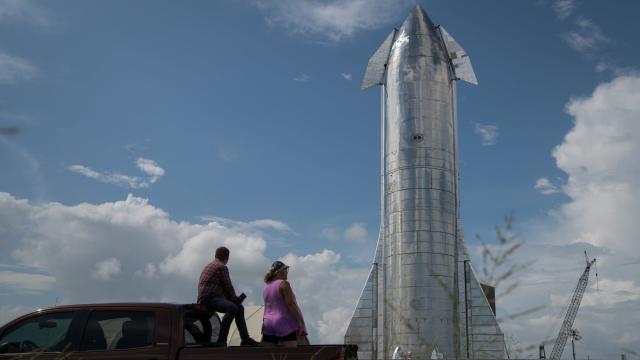SpaceX and Tesla CEO Elon Musk unveiled the towering Mk1 prototype of his Starship space vehicle on Saturday in Boca Chica Village, Texas, announcing that the craft will be ready to fly within the next few months.
According to the New York Times, Musk claimed that within one or two months the 50-metre-tall, 200-ton Starship prototype could commence an unmanned test flight that will see it fly 20km up and return to the ground intact. Musk told reporters, “It’s going to be pretty epic to see that thing take off and come back.”
The prototype, displayed alongside SpaceX’s original Falcon 1 rocket on Saturday, is made of stainless steel rather than the carbon composite or aluminium-based materials, which Ars Technica noted gives it “exceptional thermal properties” and a lower cost:
At extremely cold temperatures, stainless steel 301 does not turn brittle; and at the very high temperatures of atmospheric reentry, it does not melt until reaching 1500 degrees Centigrade. Starship therefore requires only a modest heat shield of glass-like thermal tiles.
Another benefit is cost, which matters to a company building Starships on its own dime, with the intent to build many of them. Carbon fibre material costs about [$190,000] a ton, he said. Stainless steel sells for [$3,700] a ton.
“Stainless steel is by far the best design decision we have made,” Musk said, according to Ars Technica. “… Steel is easy to weld, and weather resistant… Honestly, I’m in love with steel.”
11 years ago today, we launched our first successful mission. To date, we’ve completed 78 launches and have developed the world’s only operational reusable orbital class rockets and spacecraft—capable of launching to space, returning to Earth, and flying again pic.twitter.com/5L0q9PJ90P
— SpaceX (@SpaceX) September 29, 2019
On the transporter pic.twitter.com/CGNj1MlKAU
— Elon Musk (@elonmusk) September 26, 2019
Musk — who has a habit of wild proclamations and claims that Starship will eventually carry colonists to Mars — said that a refined Starship paired with a Super Heavy booster stage, which will increase the rocket’s height to 118 metres and be capable of carrying 99,790kg, could be ready for orbital flights within six months. Musk added SpaceX “could potentially see people flying next year,” according to the Times. The paper noted that experts say little about Starship is considered infeasible other than its business model, as the rocket is outlandishly large for most commercial uses:
Experts say the technology of Starship lies within the realm of the possible, without requiring impossible physics or unlikely technological leaps. Indeed, Starship employs many ideas that were studied decades ago but never built.
What is more puzzling to them is how SpaceX can make money with Starship. Mr. Musk agreed that it was far larger than necessary to launch current satellites.
For now, Mr. Musk conceded, there is not much of a commercial market—“not that’s especially relevant” — for Starship to fill.
Possible uses include launching SpaceX’s Starlink internet satellite network (which astronomers have worried could interfere with scientific research and contribute to space junk) and presumably very expensive international travel. Musk told reporters, the Times wrote, that Starship could complete a New York to Tokyo trip in 30 minutes and “It’s basically an I.C.B.M. that lands. Nothing gets there faster than a I.C.B.M. It’s just minus the nuclear bomb and add landing.”
“With any development into uncharted territory, its difficult to predict these things with precision,” Musk added, according to CBS News. “But I do think things are going to move very fast.”
Musk also predicted that the long-term costs of Starship will come below initial estimates, CNN reported, saying it was “probably closer to a two or three [billion] than it is to 10.” The reusable nature of the spaceship is critical, Musk added, “In almost any motor transport — whether it’s a plane or car, a horse, or bicycle — it’s reusable. If you could use a car only once, very few people could afford to drive a car. So the critical breakthrough that’s necessary is a rapidly reusable orbital rocket.”
NASA administrator Jim Bridenstine seemed less enthusiastic, fairly clearly calling out SpaceX and Musk in a tweet that suggested the company should instead be focusing on the repeatedly delayed Commercial Crew Program.
SpaceX’s Crew Dragon program, which along with competitor Boeing’s CST-100 Starliner project is intended to replace the retired space shuttle, is years behind schedule; a Crew Dragon capsule exploded in April 2019, though SpaceX later identified the issue.
“I am looking forward to the SpaceX announcement tomorrow,” Bridenstine wrote on Saturday. “In the meantime, Commercial Crew is years behind schedule. NASA expects to the same level of enthusiasm focused on the investments of the American taxpayer. It’s time to deliver.” For his part, Musk has denied that the work on Starship has at all interfered with the delivery timeline for the Dragon capsules (and NASA’s inspector general and former NASA deputy administrator Lori Garver have both pointed to funding shortfalls as reasons for the delays).
My statement on @SpaceX‘s announcement tomorrow: pic.twitter.com/C67MhSeNsa
— Jim Bridenstine (@JimBridenstine) September 27, 2019
Musk said that the next five to six months will see SpaceX building multiple new iterations of Starship, as well as ramping up rocket engine production to a target of one per day by early 2020.
“The rate at which we will be building ships is going to be quite, quite crazy by space standards,” Musk said, according to NPR.
